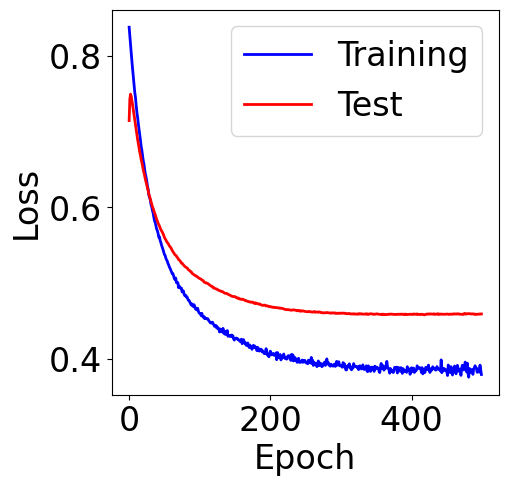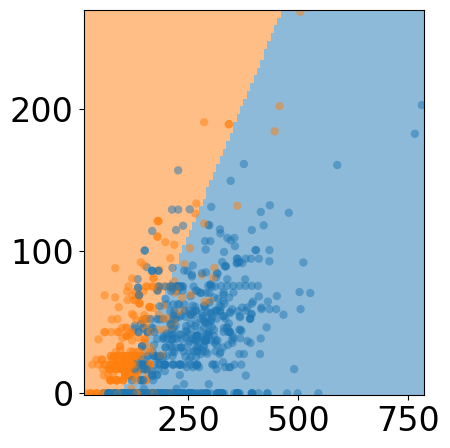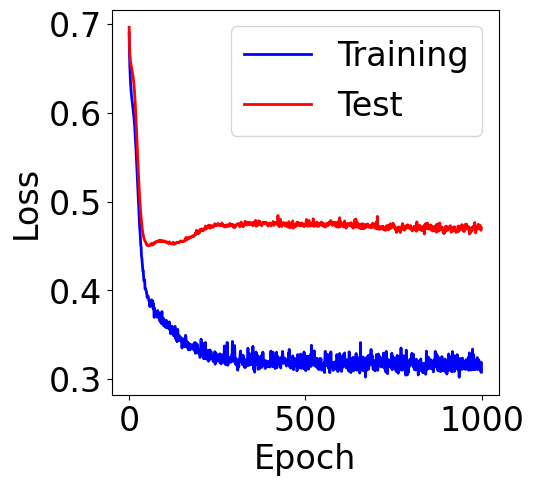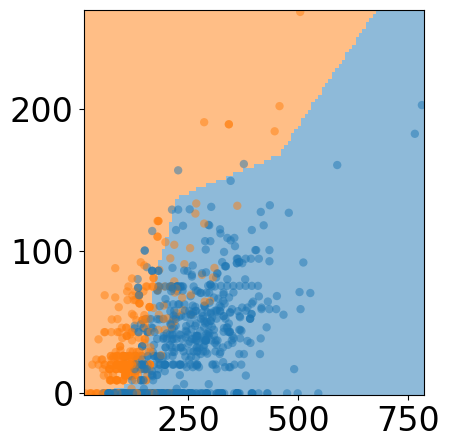Multilayer Perceptron (MLP) - An example to compare the linear model with the MLP¶
[ ]:
!pip install pandas numpy matplotlib torch wget seaborn scikit-learn
[2]:
import numpy as np
import pandas as pd
from sklearn.metrics import confusion_matrix
from sklearn.preprocessing import StandardScaler
from sklearn.decomposition import PCA
import torch
import torch.nn as nn
import torch.nn.functional as F
import matplotlib as mpl
import matplotlib.pyplot as plt
from matplotlib.colors import ListedColormap
cmap = plt.get_cmap('tab10')
colors = [cmap(i) for i in range(cmap.N)]
mpl.rcParams["font.size"] = 24
mpl.rcParams["lines.linewidth"] = 2
Load Dataset¶
[3]:
!python -m wget https://raw.githubusercontent.com/deepchem/deepchem/master/datasets/delaney-processed.csv \
--output delaney-processed.csv
Saved under delaney-processed.csv
[4]:
DELANEY_FILE = "delaney-processed.csv"
TASK_COL = 'measured log solubility in mols per litre'
df = pd.read_csv(DELANEY_FILE)
print(f"Number of molecules in the dataset: {df.shape[0]}")
Number of molecules in the dataset: 1128
[5]:
X = df[[
"Molecular Weight",
"Polar Surface Area"]].values
Y = (df[TASK_COL].values.reshape(-1, 1) >= -2).astype(int)
print("Shape of X:", X.shape)
print("Shape of Y:", Y.shape)
Shape of X: (1128, 2)
Shape of Y: (1128, 1)
[6]:
device = "cuda" if torch.cuda.is_available() else "cpu"
print("Device:", device)
Device: cpu
Linear Model¶
[7]:
class LinearRegresion(torch.nn.Module):
def __init__(self, indim):
super(LinearRegresion, self).__init__()
self.norm = nn.BatchNorm1d(indim)
self.linear = torch.nn.Linear(indim, 1)
def forward(self, x):
x = self.norm(x)
x = self.linear(x)
return x
MLP Model¶
MLP containing 2 hidden layers and with 2 input features (Molecular Weight”, “Polar Surface Area).
[8]:
import torch
import torch.nn as nn
import torch.nn.functional as F
class MLPRegresion(torch.nn.Module):
def __init__(self, in_dim):
super(MLPRegresion, self).__init__()
self.model = nn.Sequential(*[
# Normalizes input features.
nn.BatchNorm1d(in_dim),
# input -> hidden layer 1
# 10 neurons in hidden layer 1
nn.Linear(in_dim, 10),
nn.ReLU(),
# hidden layer 1 -> hidden layer 2
# 5 neurons in hidden layer 2
nn.Linear(10, 5),
nn.ReLU(),
# hidden layer 2 -> output
nn.Linear(5, 1),
])
def forward( self, x):
for layer in self.model:
x = layer(x)
return x
Training Utils¶
[9]:
def train_one_epcoh(model, criterion, optimizer, dataloader):
losses = []
model.train()
for x, y_true in dataloader:
if device == "cuda":
x, y_true = x.to(device), y_true.to(device)
x, y_true = x.float(), y_true.float()
optimizer.zero_grad() #initalize the gradients to be zero
output = model(x) # forward progagation in Pytorch
y_pred = torch.sigmoid(output) # sigmoid transformation to obtain y^hat
# cross entropy loss
loss = criterion(y_pred, y_true.reshape(y_pred.shape))
loss.backward() # backprogagation
optimizer.step() # update gradient for 1 step
losses.append(loss.cpu().detach().item()) # record the loss .detach()
return losses
# no backprogagation, no optimization
def val_one_epcoh(model, criterion, dataloader):
losses = []
model.eval()
with torch.no_grad():
for x, y_true in dataloader:
if device == "cuda":
x, y_true = x.to(device), y_true.to(device)
x, y_true = x.float(), y_true.float()
output = model(x)
y_pred = torch.sigmoid(output)
loss = criterion(y_pred, y_true.reshape(y_pred.shape))
losses.append(loss.cpu().detach().item())
return losses
Prepare Dataset¶
[10]:
from sklearn.model_selection import train_test_split
# training/validation dataset
test_size = int(len(X)*0.1)
X_train, X_test, y_train, y_test = train_test_split(X, Y, test_size=test_size, shuffle=True)
# create dataloaders
# X_train, X_test, y_train, y_test = map(torch.tensor, (X_train, X_test, y_train, y_test))
X_train, X_test, y_train, y_test = map(
lambda x: torch.tensor(x, dtype=torch.float32), (X_train, X_test, y_train, y_test)
)
batch_size = 128
train_data = torch.utils.data.TensorDataset(X_train, y_train)
train_loader = torch.utils.data.DataLoader(train_data, batch_size=batch_size,
shuffle=True, drop_last=False)
test_data = torch.utils.data.TensorDataset(X_test, y_test)
test_loader = torch.utils.data.DataLoader(test_data, batch_size=batch_size,
shuffle=False, drop_last=False)
[11]:
# grid data for visualization
x_min, x_max = X_train[:, 0].min(), X_train[:, 0].max()
y_min, y_max = X_train[:, 1].min(), X_train[:, 1].max()
xx = np.linspace(x_min, x_max, 100)
yy = np.linspace(y_min, y_max, 100)
xx, yy = np.meshgrid(xx, yy)
grids = np.hstack([xx.ravel().reshape(-1, 1), yy.ravel().reshape(-1, 1)])
grid_data = torch.utils.data.TensorDataset(
torch.tensor(grids).float()
)
grid_loader = torch.utils.data.DataLoader(grid_data, batch_size=batch_size,
shuffle=False, drop_last=False)
Train Logistic Model¶
[12]:
model = LinearRegresion(2)
model = model.to(device)
model = model.float()
criterion = torch.nn.BCELoss() # Selection of the binary cross entrpy loss
optimizer = torch.optim.SGD(model.parameters(), lr=0.01) #batch gradient descent
n_epochs = 500
train_loss = []
val_loss = []
for epoch in range(n_epochs):
losses = train_one_epcoh(model, criterion, optimizer, train_loader) # training
train_loss.append(np.mean(losses)) # average losses of the batches within the epoch
losses = val_one_epcoh(model, criterion, test_loader) # testing
val_loss.append(np.mean(losses))
[13]:
f, ax = plt.subplots(1, 1, figsize=(5,5))
ax.plot(train_loss, c="blue", label="Training")
ax.plot(val_loss, c="red", label="Test")
plt.xlabel("Epoch")
plt.ylabel("Loss")
plt.legend()
[13]:
<matplotlib.legend.Legend at 0x78d2d9293aa0>

[14]:
model.eval()
truth = []
preds = []
with torch.no_grad():
for x, y_true in test_loader:
if device == "cuda":
x, y_true = x.to(device), y_true.to(device)
x, y_true = x.float(), y_true.float()
output = model(x)
y_pred = torch.sigmoid(output).reshape(-1)
preds.extend([y_pred[i].item() for i in range(len(y_pred))])
y_true = y_true.reshape(y_pred.shape)
truth.extend([y_true[i].item() for i in range(len(y_true))])
confusion_matrix(np.array(truth), np.array(preds)>0.5)
[14]:
array([[60, 9],
[11, 32]])
[15]:
predictions = []
model.eval()
with torch.no_grad():
for x, in grid_loader:
if device == "cuda":
x = x.to(device)
x = x.float()
output = model(x)
y_pred = torch.sigmoid(output).reshape(-1)
predictions.extend([y_pred[i].item() for i in range(len(y_pred))])
# plot space separation
fig, ax = plt.subplots(1, 1, figsize=(5, 5))
custom_cmap = ListedColormap([cmap(0), cmap(1)])
mesh_pred = np.array(predictions).reshape(xx.shape)
plt.pcolormesh(xx, yy, mesh_pred>=0.5,
cmap=custom_cmap, alpha=0.5)
plt.scatter(X_train[:, 0], X_train[:, -1],
c=y_train, cmap=custom_cmap,
edgecolors='none', alpha=0.5)
fig.tight_layout()

Train MLP Model¶
[16]:
model = MLPRegresion(2) # 2 input features
model = model.to(device)
model = model.float()
criterion = torch.nn.BCELoss()
optimizer = torch.optim.SGD(model.parameters(), lr=0.05)
n_epochs = 1000
train_loss = []
val_loss = []
for epoch in range(n_epochs):
losses = train_one_epcoh(model, criterion, optimizer, train_loader)
train_loss.append(np.mean(losses))
losses = val_one_epcoh(model, criterion, test_loader)
val_loss.append(np.mean(losses))
[17]:
f, ax = plt.subplots(1, 1, figsize=(5,5))
ax.plot(train_loss, c="blue", label="Training")
ax.plot(val_loss, c="red", label="Test")
plt.xlabel("Epoch")
plt.ylabel("Loss")
plt.legend()
[17]:
<matplotlib.legend.Legend at 0x78d2d928e2d0>

[18]:
model.eval()
truth = []
preds = []
with torch.no_grad():
for x, y_true in test_loader:
if device == "cuda":
x, y_true = x.to(device), y_true.to(device)
x, y_true = x.float(), y_true.float()
output = model(x)
y_pred = torch.sigmoid(output).reshape(-1)
preds.extend([y_pred[i].item() for i in range(len(y_pred))])
y_true = y_true.reshape(y_pred.shape)
truth.extend([y_true[i].item() for i in range(len(y_true))])
confusion_matrix(np.array(truth), np.array(preds)>0.5)
[18]:
array([[63, 6],
[12, 31]])
[19]:
predictions = []
model.eval()
with torch.no_grad():
for x, in grid_loader:
if device == "cuda":
x = x.to(device)
x = x.float()
output = model(x)
y_pred = torch.sigmoid(output).reshape(-1)
predictions.extend([y_pred[i].item() for i in range(len(y_pred))])
# plot space separation
fig, ax = plt.subplots(1, 1, figsize=(5, 5))
custom_cmap = ListedColormap([cmap(0), cmap(1)])
mesh_pred = np.array(predictions).reshape(xx.shape)
plt.pcolormesh(xx, yy, mesh_pred>=0.5,
cmap=custom_cmap, alpha=0.5)
plt.scatter(X_train[:, 0], X_train[:, -1],
c=y_train, cmap=custom_cmap,
edgecolors='none', alpha=0.5)
fig.tight_layout()

[19]: